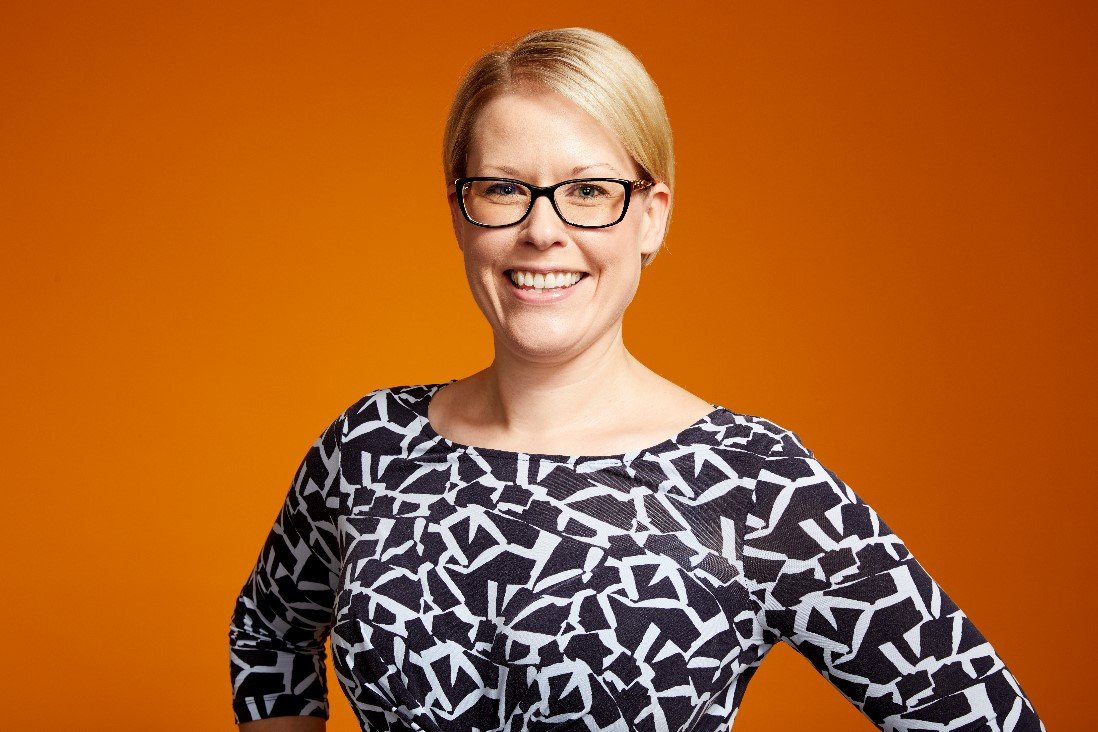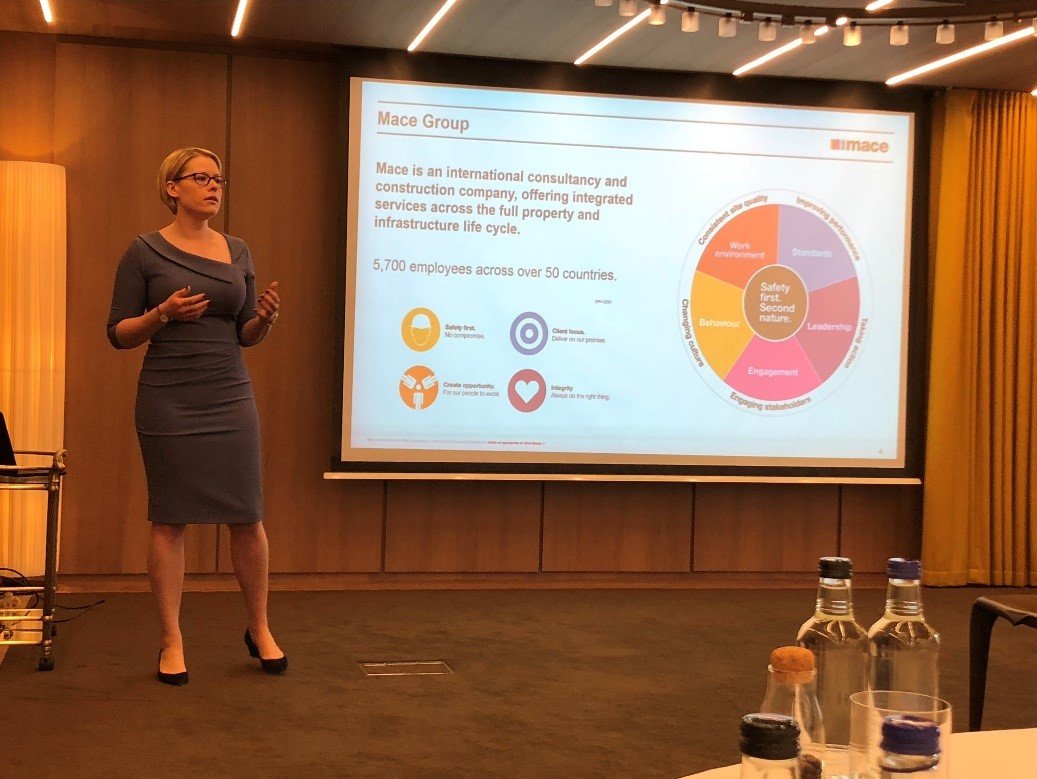Judith Grant, Associate Director of Health and Wellbeing at Mace Group, welcomed a packed room to the latest in the Women in Health and Safety programme, to talk about the importance of tangible and strategic wellbeing at work.
Judith Grant is Associate Director of Health and Wellbeing at Mace and is responsible for strategic health and wellbeing delivery across the global company. As the former Group Head of Occupational Health and Wellbeing at Royal Mail Group Judith achieved success in developing and delivering wellbeing strategy and programmes. With a background that includes working in community health for a local authority, in corporate health promoting wellbeing programmes to businesses and personal training both for a gym and privately, Judith has a varied background in health and wellbeing promotion. Judith is on the Women in Health and Safety Committee and recently shared her personal story at a Women in Health and Safety event.

Judith’s story
“I actually weigh less today than I did at the age of 12! My weight increased year on year until I was 17 when I hit 16 stone; through my teenage years I was bullied for being overweight and I used food to make myself feel better. It all changed when I was thinking about going to university; I asked my parents for gym membership for my 17th birthday present, and it all went from there! I discovered the high I felt through eating could also be experienced following exercise. I found it a struggle losing the weight, having to completely rethink my attitude to food and exercise.
An exercise obsession
I went to university to study for a degree in Economics but over a year into it I realised that this was not the degree course for me. That is when I decided to become a personal trainer; I wanted to help others feel better about themselves as I did. So I trained as a personal trainer and then returned to university for a Sport and Exercise Science degree. Over these three years what had years ago been an obsession for eating turned to an exercise obsession leaving me with debilitating leg injuries. It came to a head one day shortly before my final exams when I simply couldn’t walk the short distance from the university library back home. A few weeks later I had my first double leg surgery which gave me some relief for a year, but it was clear it had not fixed the issue. I was unable to work as a personal trainer so took a job in a call centre. Then followed another double leg surgery which only gave relief for a few weeks. The next year saw test after test checking my bones, muscles, veins through all kinds of torturous tests, while I was finally unable to walk without crutches. Over this time I felt anxious and experienced multiple panic attacks as I struggled to cope with the pain and uncertainty. I was signed off work and went home to live with my parents as I could no longer drive or easily look after myself. At the age of 25 this was not how I had pictured my life.
Surgery
It was during this time staying with my parents I decided that there must be another way. I wasn’t quite prepared to accept the prognosis that I would soon need a wheelchair and pain medication for life. With the help of the surgeon who had done my last operations, I researched conditions of the lower limb and together we found some research on a condition called Popliteal Entrapment Syndrome. The symptoms sounded just like mine – so with a little help, I found a vascular surgeon and persuaded him to operate. Incredibly, after an agonising few days in hospital, and a large scar down the back of my thigh, across the back of my knee and down my calf, it was clear that it had worked. The chronic pain I had lived with for the last six years had cleared and I could feel my lower leg again! Six rather impatient months later they operated on the other leg, and six months after that I got a job as a personal trainer.
Words of wisdom from fellow hospital patient
One thing that stuck with me from my final stay in hospital was the other women in my ward. Vascular wards are both terrifying and inspiring places – where surgeons can carry out operations so intricate that you marvel at medical science, yet human life is so clearly on a knife edge. The 90 year old lady in the bed opposite mine has stayed in my mind and will never know the impact she had on my life. In those three days we spent in the same ward she told me about her travels around the world with her husband and it was clear she had lived every one of those 90 years! As I was about to leave the hospital, with a great prognosis, she said to me “you can do anything you want now”, I really felt I had been given a second chance. Those words stayed with me, and my career and academic endeavours since reflect that. I loved being a personal trainer and working with people to help them lose weight but I wanted to do more. I took a role in community health delivering health promotion work in schools, community groups and workplaces. It was then I realised that workplace health was the career path I wanted to take.
Workplace health and wellbeing

I completed my Nebosh (National Examination Board in Occupational Safety and Health) in Health and Safety and an MSc in Workplace Health and Wellbeing, whilst first working for a workplace health promotion programme called the Global Corporate Challenge and then working as Head of Occupational Health and Wellbeing at the Royal Mail. I was fortunate enough to gain a scholarship to complete a PhD and four and a half years on have just submitted my thesis. My research has focused on socioeconomic status, obesity and eating behaviours in the workplace and this has had a significant influence on the way I now approach my role in Health and Wellbeing at work. The research on socioeconomic disparities in health is widespread and while average life expectancy is growing the gap between rich and poor is widening. The workplace has a unique opportunity to encourage healthy behaviours and provide support for all employees no matter how much they earn or their level of formal education. We as practitioners must consider how accessible, inclusive and engaging the programmes we implement are in order that they do not further the disparities in health, but give all employees equal opportunity to access support if they want it.”
“There is no one-size fits all model of wellbeing and that is why measuring a baseline and gathering information from employees is the best place to start.”
What makes us susceptible to burnout?
In this episode of the Safety & Health Podcast, ‘Burnout, stress and being human’, Heather Beach is joined by Stacy Thomson to discuss burnout, perfectionism and how to deal with burnout as an individual, as management and as an organisation.
We provide an insight on how to tackle burnout and why mental health is such a taboo subject, particularly in the workplace.




I attended this event and really found it interesting.